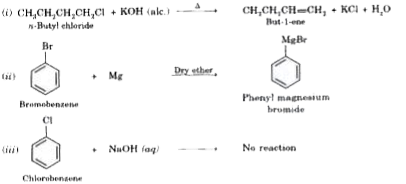What happens when
(i) n-butyl chloride is treated with alcoholic KOH,
(ii) bromobenzene is treated with Mg in the presence of dry ether,
(iii) chlorobenzene is subjected to hydrolysis,
(iv) ethyl chloride is treated with aqueous KOH,
(v) methyl bromide is treated with sodium in the presence of dry ether,
(vi) methyl chloride is treated with KCN?
(i) CH3CH2CH2CH2Cln-Butyl chloride+KOH(alc.)Δ−−→CH3CH2CH=CH2But-1-ene+KCl+H2O

(iv) CH3CH2ClEthyl chloride+KOH(aq.)Δ−−→CH3CH2OHEthanol+KCl+H2O
(v) 2CH3Br+2NaDry ether−−−−−−−−→Wurtz reactionCH3CH3Ethane+2NaBr
(vi) CH3ClMethylchloride+KCN(alc.)→CH3CNMethylcyanide+KCl
Topper's Solved these Questions
- HALOALKANES AND HALOARENESBOOK - MODERN PUBLICATIONCHAPTER - HALOALKANES AND HALOARENESEXERCISE - NCERT examplar Problems (Multiple Choice Questions (Type-I))
31 Videos
- HALOALKANES AND HALOARENESBOOK - MODERN PUBLICATIONCHAPTER - HALOALKANES AND HALOARENESEXERCISE - NCERT examplar Problems (Multiple Choice Questions (Type-II))
12 Videos
- HALOALKANES AND HALOARENESBOOK - MODERN PUBLICATIONCHAPTER - HALOALKANES AND HALOARENESEXERCISE - NCERT Textbooks Exercises
1 Videos
- EQUILIBRIUMBOOK - MODERN PUBLICATIONCHAPTER - EQUILIBRIUMEXERCISE - Unit Practice Test
13 Videos
- HYDROCARBONSBOOK - MODERN PUBLICATIONCHAPTER - HYDROCARBONSEXERCISE - UNIT PRACTICE TEST
15 Videos
Similar Questions
What happens when
(i) n-butyl chloride is treated with alcoholic KOH,
(ii) bromobenzene is treated with Mg in the presence of dry ether,
(iii) chlorobenzene is subjected to hydrolysis,
(iv) ethyl chloride is treated with aqueous KOH,
(v) methyl bromide is treated with sodium in the presence of dry ether,
(vi) methyl chloride is treated with KCN?
View SolutionWhat happens when
n-butyl chloride is treated with alcoholic KOH.
View SolutionWhat happens when : (i) Ethyl chloride is treated with aqueous KOH ?
(ii) Methyl bromide is treated with sodium in the presence of dry ether?
View SolutionWhat happens when
methyl bromide is treated with sodium in the presence of dry ether.
View SolutionWhat happens when
methyl chloride is treated with KCN ?
View SolutionWhat happens when ethyl chloride is treated with aqueous KOH?
View SolutionWhat happens when
bromobenzene is treated with Mg in the presence of dry ether.
View SolutionWhat happens when
ethyl chloride is treated with aqueous KOH.
View SolutionWhat happens when ethyl chloride is treated with aqueous KOH?
View SolutionTert-Butyl bromide is treated with sodium metal in dry ether.
View Solution
